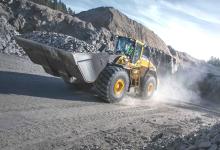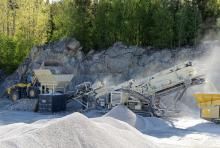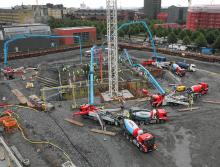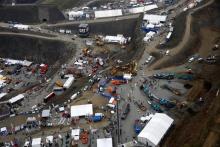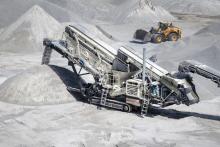
Scandinavia’s aggregates industry is gearing up for a period of welcome steady growth, as Jon Masters reports.
Quarry operators and their equipment suppliers can look forward to some good growth numbers in the Scandinavian countries of Sweden, Denmark and Norway. There is the caveat of economic warning signs suggesting the region may dip back into recession, but aggregates demand is expected to be maintained. And in all likelihood, orders will increase steadily over the next year or two as growth returns to Scandinavia’s infrastructure and housing markets.
This picture is built by a number of influencing factors, not least the fact that aggregates markets have held up relatively unscathed compared to other industries. Undoubtedly, demand for rock, sand and gravel took a big hit as Europe’s economies nosedived 5-6 years ago. But by 2012, Sweden’s aggregates output was back on the up, improving 2% to 78.7 million tonnes, according to the country’s geological survey SGU.
Equivalent production of Norway and Denmark was roughly 60 million tonnes and 45 million tonnes respectively, says
“With construction activity being the main driver of aggregates demand, particularly infrastructure and housing, the markets of all three countries took some pretty large losses between 2008 and 2012.
“They now have decent prospects for growth depending on how far out the forecasting is done. There are two or three major projects expected to start within the next few years, which will have a big effect on aggregates demand,” Mytko says.
One of these keenly awaited major infrastructure schemes is the circa €5.5 billion Fehmarnbelt Fixed Link, which will feature an 18km immersed tube tunnel connecting Denmark and Germany. The 89,217m-long, precast concrete tunnel sections
will be built and floated out from a coastal factory east of the Danish portal site at Rodbyhavn. Each will contain two tubes for a dual three lane motorway, an emergency evacuation tunnel and two tubes for a high speed rail line between Hamburg and Copenhagen.
The Fehmarnbelt Link and its many associated developments, including road and rail upgrades, will boost aggregates production in the region. Scandinavia already has well developed and expansive infrastructure, Mykto says.
Maintenance requirements are considerable, especially so due to the region’s relatively harsh climate, all of which ensures substantial demand for aggregates even when economic conditions are less favourable.
“The harsh winters ensure investment is required; a lot of damage is done if not, so there is a certain level of aggregates demand at all times,” says
“We have seen some growth over the last few years and we expect greater still over the coming financial year. It will not be massive, probably only single digit market growth, but we can see our clients’ activities expanding with some strong prospects over the longer term.”
Other signs of future growth include urban development plans centred on Sweden’s main cities of Stockholm, Gothenburg and Malmo. Stockholm has laid down plans for a 30km ring road to relieve congestion and a rail link connecting to the north of Sweden is gathering political support.
Norway is similar, with significant road and housebuilding plans for its main cities. Housing markets, particularly in Norway, have cooled as lending conditions have been tightened, reports the OECD (Organisation for Economic Cooperation & Development), but it also predicts gathering economic momentum driven by private investment and consumption.
“There are mixed messages going around on the region’s economic situation,” says Takaluoma. “Scandinavia recovered relatively quickly from Europe’s overall crash, but economies in the region now seem to have stalled and appear on the edge of a second recession. Growth overall is slow, or even declining, which is having an impact on jobs, but the aggregates market is stable.”
Such stability is a good thing, Takaluoma adds. A steady state, however slow, is preferable to spikes and slumps for effective planning. There appears to be general agreement on this, as there is recognition that infrastructure investment is a sound way of generating growth and employment.
“There is a general expectation of expansion as a lot of the region’s infrastructure needs to be updated. There will not be any doubling of numbers, or choice 20% growth figures, but small increases are expected.”
Sustainable growth is the term being talked about across Scandinavia, Griffiths adds. “Big fluctuations are not good. Gradual growth is better for all in the public and private sector. Longer term planning is the aim,” he says. “We’re now seeing growth trends following forecasts, which is good for us.
Norway has been better in terms of production than Sweden over the past year, purely because the former has had more going on. Sweden has been at a low point in terms of projects on site, but it will pick up.”
Slow stable growth is producing some knock-on positive effects for suppliers. Opportunities are emerging for companies such as Volvo as the big quarry operators look to generate greater margin by reducing overheads and operating costs.
“High profile mergers, such as that between
Volvo has its Sitesim simulation software for working out optimum fleet requirements over the life cycle of a project. It also provides financial services for assisting the process of buying equipment.
“As company mergers or acquisitions take place, inevitably they will need to sell off parts of their operations, which will then have to be bought by someone, who will then need to look at what they need for running that operation,” Griffiths says.
“This links to other positive trends we’re seeing. Customers are seeking optimisation of their processes, like crushing for example. This is an ideal use for our articulated trucks.”
Griffiths cites the Holcim Lafarge merger as a high profile example across Europe. These are not the big players in the Scandinavian market. Principal aggregates suppliers in Sweden, Denmark and Norway include
In some cases, more cost-effective processing means making better use of resources by buying mobile crushers and screens.
Customers are tending to circulate equipment around their sites depending on demand, Takaluoma says. Service provided by suppliers such as Metso is ever more paramount for maintaining production.
“Customer service is still priority number one and is emphasised even more now,” he adds. “Our products are continuously modified to meet customer needs. They need good processes to get a good end product, so help and support is always in demand for fine tuning quarry operations.”

